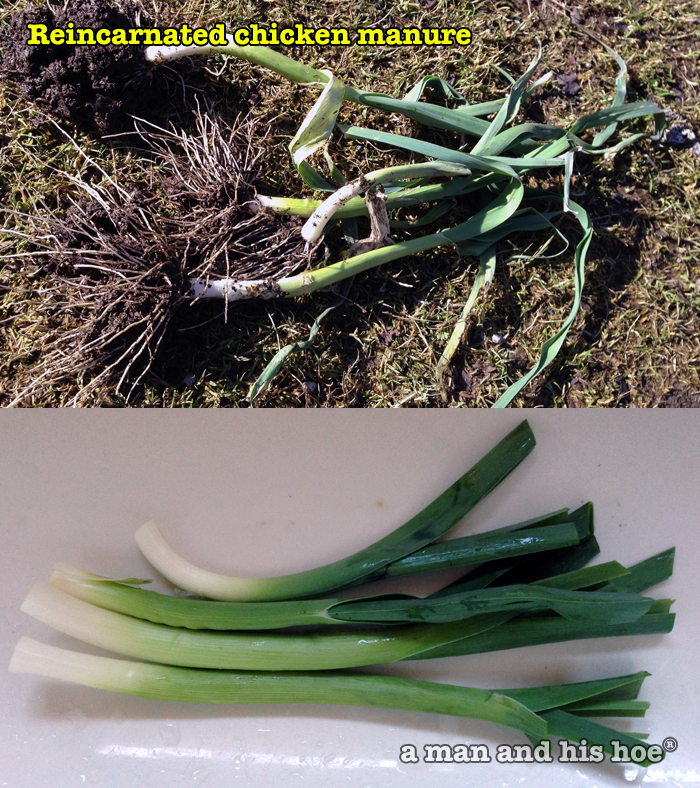
So what happens to chicken manure when it is reincarnated? It turns into edible wonders, like these over wintering onions I pulled this morning. Most chicken farmers get rid of their egg laying hens by the time they have gone through two egg laying seasons. However, on the micro scale that I operate, the manure these older hens is as valuable as the eggs they lay. I’ve had hens live more than seven years. Billy, the oldest rooster, is five years old this year.
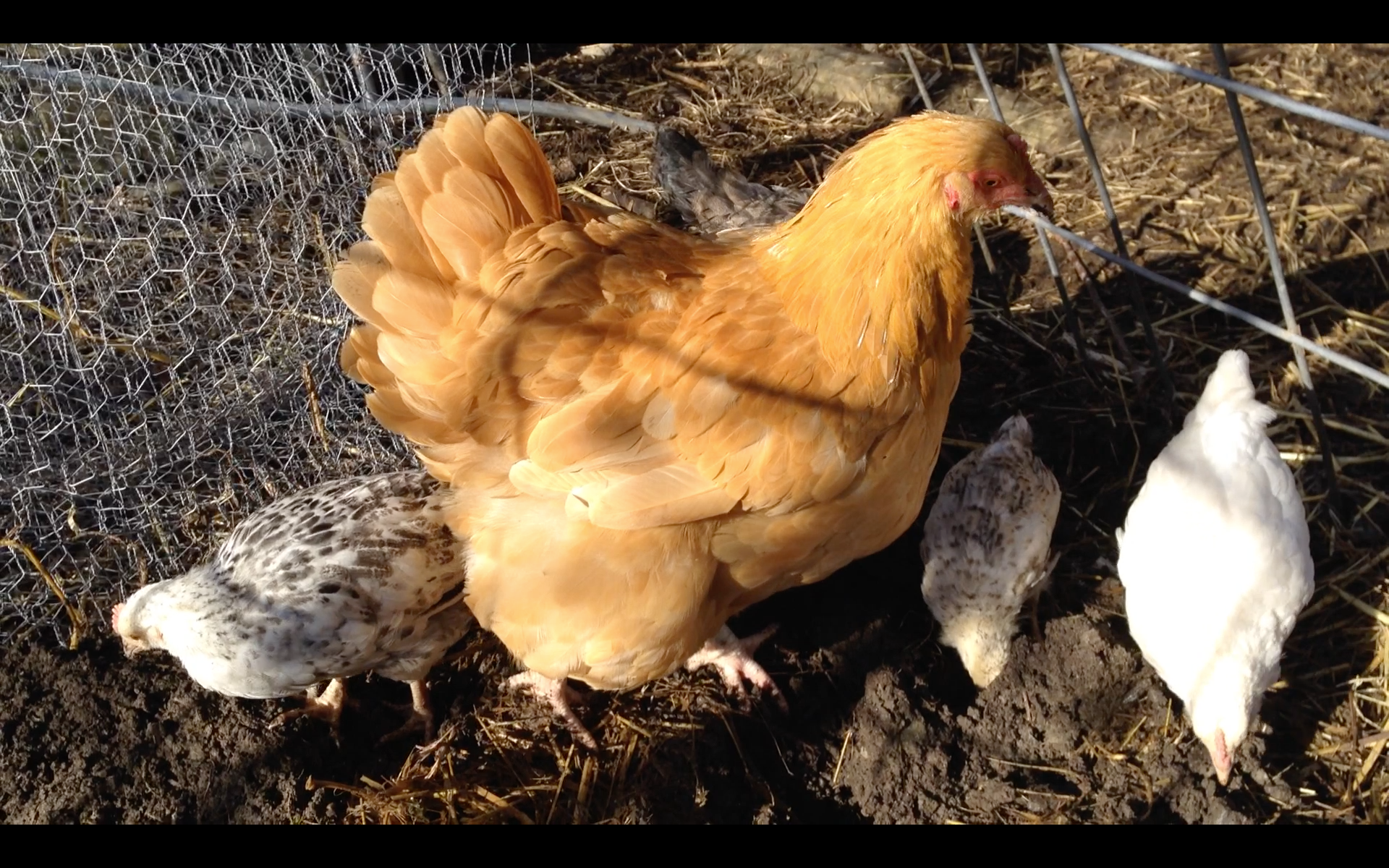
The chicks born on December 19 are 8 weeks old now. They are still spending their days and nights with their mother. Most commercial broiler chickens are in the supermarket by 8 weeks of age. These chicks are still having the time of their lives foraging for food with their mother. Here, they are digging for earthworms next to a compost pile.
-
Edible Recycled Chicken Manure
Reincarnated Chicken Manure Eight Week Old Chicks -
Much Ado About?
Subway has responded to a petition started by Food Babe’s Vani Hari to remove azodicarbonamide, a dough conditioner, from Subway breads. Subway isn’t the only company to use this additive. You’ll find it in McDonalds bread, Wonder Bread, in the bread products of many many other companies, yoga mats, shoe rubber and synthetic leather. The additive is banned in Europe and other places. Europe even bans using it in plastics which come into contact with food. The FDA considers use of azodicarbonamide as safe to use in human food. Does the FDA consider people living in the USA to be more resilient to substances considered toxic in other countries?
But maybe this notion of eating anything the FDA considers as safe isn’t the way to think of eating food. Instead of asking, “Is this safe?”, we should be asking, “Is this good? Will it make us better? Will it be something that nourishes us?” Food isn’t something we eat to improve the profit margins of corporations. Food is something we eat to give us joy, energy, and nourish us. Food is a gift we give ourselves. It should all be good, fantastic, delicious, not merely safe.
I’m baffled by all the ingredients companies put in their bread products. Below is a list of the ingredients you’ll find in Subway’s Nine-Grain Bread, a MacDonalds Big-Mac Bun, and the bread I often bake at home. Wouldn’t it be much easier to make bread out of as few ingredients as possible? And why is there any need to use preservatives in the bread of fast food companies? In the case of Subway bread, it’s eaten within minutes, hours at the most of baking. Why add Calcium Propionate and/or Sodium Propionate at all?
Subway 9-Grain Wheat Bread - Enriched wheat flour (wheat flour, malted barley flour, niacin, iron, thiamine mononitrate, riboflavin, folic acid)
- water
- yeast
- whole wheat flour
- sugar
- wheat gluten
- oat fiber
- soybean oil
- wheat bran
- salt
- wheat
- rye
- yellow corn
- oats
- triticale
- brown rice
- barley
- flaxseed
- millet
- sorghum
- yeast nutrients (calcium carbonate, calcium sulfate, ammonium sulfate)
- vitamin D2
- dough conditioners
- DATEM
- sodium stearoyl lactylate
- potassium iodate
- ascorbic acid
- azodicarbonamide
- caramel color
- refinery syrup
- honey
- yeast extract
- natural flavor
- enzymes
MacDonalds Big Mac Bun - Enriched Flour (Bleached Wheat Flour, Malted Barley Flour, Niacin, Reduced Iron, Thiamin Mononitrate, Riboflavin, Folic Acid)
- Water
- High Fructose Corn Syrup and/or Sugar
- Yeast
- Soybean Oil and/or Canola Oil
- Salt
- Wheat Gluten
- Calcium Sulfate
- Calcium Carbonate
- Ammonium Sulfate
- Ammonium Chloride
- Dough Conditioners (May Contain One or More of):
- Sodium Stearoyl Lactylate
- DATEM
- Ascorbic Acid
- Azodicarbonamide
- Mono and Diglycerides
- Ethoxylated Monoglycerides
- Monocalcium Phosphate
- Enzymes
- Guar Gum
- Calcium Peroxide
- Sorbic Acid
- Calcium Propionate and/or Sodium Propionate (Preservatives)
- Soy Lecithin
- Sesame Seed
My Bread - whole wheat flour
- water
- salt
- yeast
-
Staying Warm
[wpvideo rA8Rcrdn]
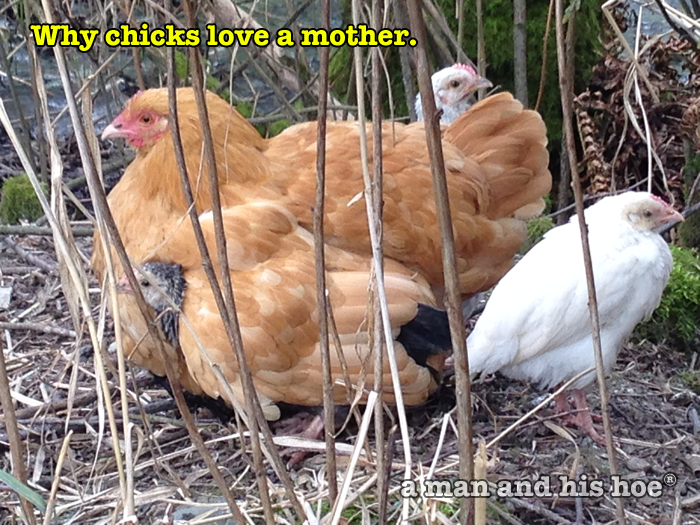
Staying Warm
These chicks are seven weeks and still have a ways to go before they are independent. Many broiler chicks have already been butchered by the time they are this old, and most only have another week or two before they are off to market. These heritage breed mix chicks are many months away from the dinner table.

Staying Warm -
Edison Bird Festival
[wpvideo or95gIL8]
It’s early February – time for Edison’s Annual Bird Festival in the one and only village of Edison, Washington.

Edison Bird Festival
Where else in the world is there a festival which rollerbladers dressed as chickens racing down the main drag? It’s a short two and a half block long race and what a blast.

Edison Bird Festival
After the race, it’s time for the “Be the Chicken!” Chicken Parade. Many people bring their chickens and walk them, carry them, pull them in carts through town.

Edison Bird Festival
It was cold, clear day, perfect weather for a winter festival. If you missed it this year, make plans now to be in Edison next February.
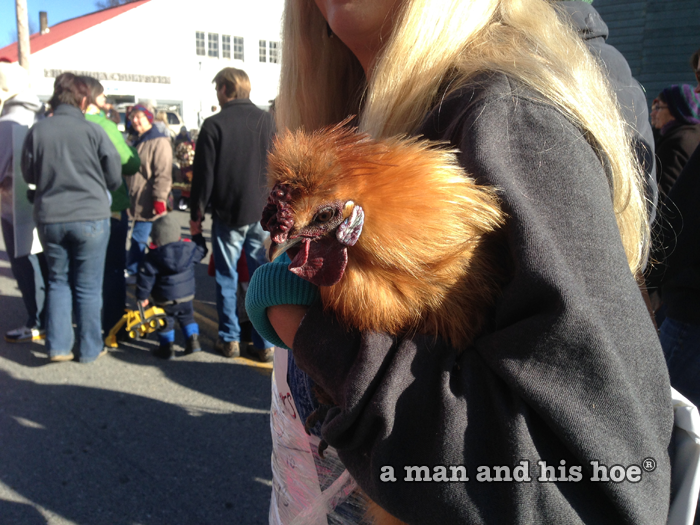
Edison Bird Festival -
Guard Dogs
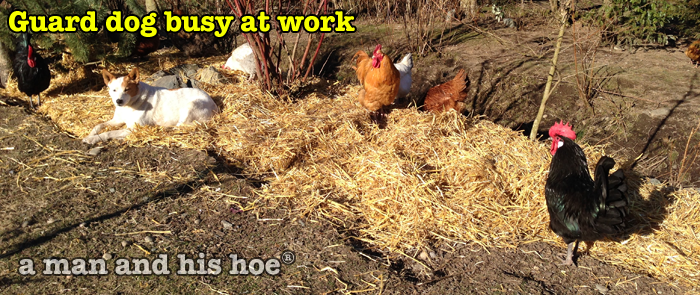
Guard Dog If you are planning on having chickens roam free, it makes a big difference if you have guard dogs. Good ones will detect coyotes venturing too close, chase off raccoons, hunt down opossums, and keep the hawks and eagles away.
Our two guard dogs are fearless. Working as a team, they chase coyotes far off into the woods. The chickens get along with the dogs so well that some of the chickens lay eggs in their dog houses. The dogs love that.
The dogs also sometimes break up roosters which get into a fight.